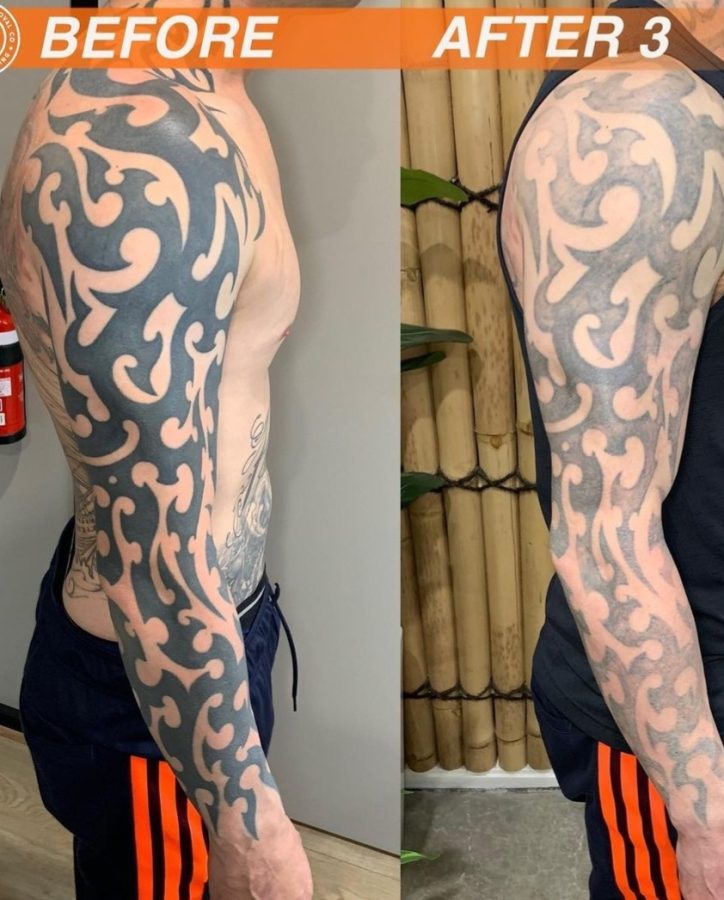Permanent tattoos can go against their title, but not without intense removal processes

More stories from Eva Harshman
A before and after comparison of laser tattoo removal showing the slow progress of the process.
“Think long and hard about getting a tattoo because that is a permanent mark on your body.”
Many people who have considered getting a tattoo may have heard this caution when confiding in someone about their wishes for a body modification. And truly, this sentiment is nearly accurate—professional tattoos don’t fade away like a stick and poke or a temporary.
However, with increasingly advanced technology, tattoos are becoming less and less permanent—somewhat. The entire point of tattoos is to be a permanent marking, so it is no surprise that they are extremely difficult to remove.
The means of removing a permanent tattoo are, unfortunately, fairly abrasive and often uses a powerful laser to shatter the tattoo ink through heat. It is far more expensive than getting a tattoo and more complicated as well. Because tattoo ink is below the top layer of the skin, it is difficult to reach the ink.
The effectiveness of laser surgery extremely varies. Certain colors, such as white and blue, are very rarely removed cleanly without discoloration. This leaves some peculiarities in the work when the tattoo undergoes laser treatment.
Laser is almost never a one-time fix for any tattoo. Depending on the power of the laser, the size of the tattoo, and the amount of ink used, 5-10 sessions may be needed—this can cost from hundreds to over thousands of dollars. The time between sessions is also dependent on the strength of the laser, making the whole process last over several years and very long-term.
Even so, this method doesn’t always completely rid someone of their tattoo; while it can fade into essentially oblivion, this is over a long process, so oftentimes, people fade the tattoo in order to get a cover-up.
Cover-up tattoos are a less invasive method, but for someone who doesn’t want tattoos at all, this is not a viable option. Additionally, not all tattoos can be covered up without showing through. Hence, some go for another more aggressive option.
Dermabrasion is another manner of tattoo removal, but this time, without the use of lasers. While lasers can cause blisters and hyperpigmentation, the risk of using dermabrasion is often higher.
Dermabrasion is the removal of the layers of skin containing the tattoo ink in a controlled manner—essentially, the skin is being sanded down. This sounds very graphic and gross, and that’s simply because it is. Dermabrasion is universally effective against nearly every type of tattoo, but it has numerous downsides.
For starters, its aesthetics are very poor, leaving scars from where the skin was pulled away. Additionally, since there is actual contact with the skin and physical removal, there is a greater risk of infection. Overall, dermabrasion is a much more drastic choice than laser, but there is an even more desperate measure.
Surgical removal of tattoos is only used in the most extreme cases where other options have been ineffective or impossible for a person to safely use. Obviously, it is very effective, since the tattoo is removed with a scalpel and the edges of the skin are stitched back together.
However, this is only practical on certain areas of the body where the skin is able to be manipulated in such a way. Additionally, it is very harsh, but it is a single operation, so the process is quick.
All three of these removal techniques have one thing in common: they are extremely harsh. When opting for an alternative removal method less harsh, the effectiveness goes down, but large decisions must be made in order to get a tattoo completely removed.
Listening to your elders might be the best option when it comes to being on the fence about getting a tattoo, but the best way to avoid getting a bad tattoo is to get something timeless and professional—something to love forever.

Eva Harshman is a senior who is thrilled to be entering her fourth and final year on staff as Editor-in-Chief. Apart from writing for The Central Trend, she...



























































































